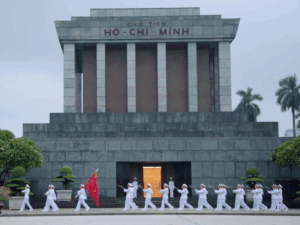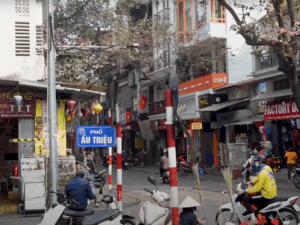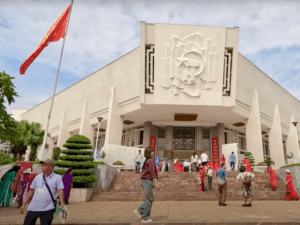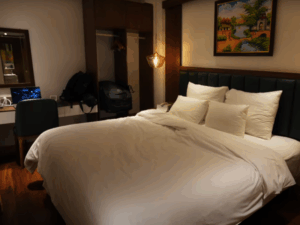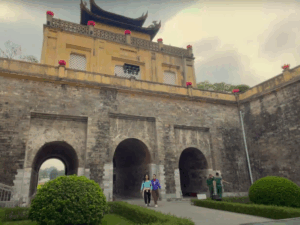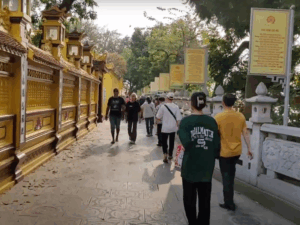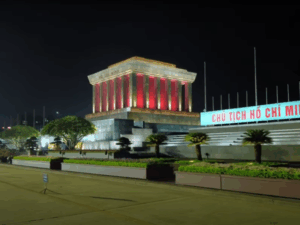The Humble Abode of a Revolutionary
Imagine stepping into a home that has seen the birth of a nation. The Ho Chi Minh Stilt House is not just a residence; it’s a symbol of resilience, humility, and dedication. Built in 1958, this house was Ho Chi Minh’s personal retreat until his passing in 1969. Its design reflects the traditional Vietnamese stilt house style, blending seamlessly with the surrounding gardens and pond.
The Origins and Construction of the Ho Chi Minh Stilt House
The Ho Chi Minh Stilt House was constructed in 1958, inspired by the traditional stilt houses of Vietnam’s ethnic minorities. These houses, elevated on stilts, are designed to withstand flooding and provide natural ventilation. Ho Chi Minh chose this simple design to reflect his commitment to a modest lifestyle, even as the leader of a burgeoning nation.
Situated within the Presidential Palace grounds, the house is surrounded by lush greenery and a serene pond. This tranquil setting provided Ho Chi Minh with a peaceful retreat from the rigors of leadership, allowing him to reflect and plan for the country’s future.
A Haven During Leadership
During his tenure, the Ho Chi Minh Stilt House served as more than just a residence. It was a place where crucial decisions were made, shaping the course of Vietnam’s history. The house’s simplicity underscored Ho Chi Minh’s philosophy of leading by example, demonstrating that true leadership stems from humility and dedication.
Throughout the years, the house has undergone several transformations to preserve its original form. Preservation efforts have ensured that the house remains a testament to Ho Chi Minh’s enduring legacy, offering visitors a chance to step back in time and experience a pivotal period in Vietnam’s history.
Architectural and Cultural Marvels
The Ho Chi Minh Stilt House is a prime example of traditional Vietnamese architecture. Elevated on wooden stilts, the house features a thatched roof and open-air design, allowing for natural ventilation and cooling. The materials used—bamboo, wood, and palm leaves—reflect the resourcefulness and sustainability inherent in Vietnamese culture.
This architectural style has influenced modern Vietnamese design, emphasizing harmony with nature and practicality. The stilt house’s open layout encourages a connection with the environment, while its simple yet functional design offers insights into the daily life and customs of Vietnam’s past.
Elements of Traditional Vietnamese Architecture
The house’s design incorporates elements of traditional Vietnamese stilt houses, which are elevated on wooden stilts to prevent flooding and protect against wildlife. The open-air structure allows for natural ventilation, keeping the interior cool and comfortable even during hot summers. The materials used—bamboo, wood, and palm leaves—are locally sourced and sustainable, reflecting Ho Chi Minh’s commitment to simplicity and environmental consciousness.
Influence on Modern Vietnamese Design
The Ho Chi Minh Stilt House has left an indelible mark on modern Vietnamese architecture. Its emphasis on sustainability and harmony with nature continues to inspire contemporary designs. The use of natural materials and open spaces has become a hallmark of Vietnamese architecture, blending tradition with modernity.
Connection to Daily Life and Traditions
The Ho Chi Minh Stilt House offers a glimpse into the daily life and customs of Vietnam’s past. Visitors can observe how traditional stilt houses were designed to accommodate the practical needs of everyday life while fostering a connection with the surrounding environment. The house’s simplicity and functionality reflect the values of a culture deeply rooted in tradition and resourcefulness.
Planning Your Visit
Planning a visit to the Ho Chi Minh Stilt House is a must for any history enthusiast or cultural explorer. The house is located within the Presidential Palace grounds in Hanoi and is easily accessible by public transportation or taxi. It is open to visitors from 8 AM to 11 AM and 2 PM to 4 PM, Tuesday to Sunday. Admission fees are nominal, and guided tours are available in multiple languages.
Notable Rooms and Artifacts
The house itself is a modest two-room structure, consisting of a study and a bedroom. The study is furnished with Ho Chi Minh’s personal desk and chair, along with books and documents that offer insights into his intellectual pursuits. The bedroom, equally simple, features a wooden bed and a mosquito net, underscoring Ho Chi Minh’s preference for a frugal lifestyle.
Visitors can also explore the grounds surrounding the house, including the garden and fish pond, which were meticulously maintained by Ho Chi Minh himself. Artifacts such as his walking stick, clothing, and personal belongings are on display, providing a deeper understanding of his daily life and work.
Guided Tours and Local Insights
Guided tours are highly recommended for a comprehensive understanding of the Ho Chi Minh Stilt House. Knowledgeable local guides share stories and anecdotes about Ho Chi Minh’s life, leadership, and the historical context of the house. These tours offer valuable insights that enhance the visitor experience, making the visit both educational and enjoyable.
The Enduring Legacy of Ho Chi Minh
Ho Chi Minh’s impact on Vietnam’s history and independence cannot be overstated. His leadership during the struggle for independence and his vision for a united Vietnam have left a lasting legacy. The Ho Chi Minh Stilt House stands as a symbol of his enduring influence, inspiring generations of leaders and citizens alike.
Global Influence and Struggles for Independence
Ho Chi Minh’s legacy extends beyond Vietnam’s borders, influencing independence movements around the world. His unwavering commitment to self-determination and social justice has resonated with leaders and activists in their own struggles for freedom. The principles he championed continue to inspire movements for justice and equality globally.
Reflections on Leadership and Values
Ho Chi Minh’s leadership style, characterized by humility, integrity, and a deep connection with the people, offers valuable lessons for leaders today. His emphasis on leading by example and prioritizing the well-being of the nation serves as a timeless model for effective and ethical leadership.
Summary of Key Takeaways
The Ho Chi Minh Stilt House is more than just a historical site; it is a testament to the values and vision of one of Vietnam’s most revered leaders. Its architectural simplicity, cultural significance, and rich history make it a must-visit destination for anyone interested in Vietnam’s past and future.
Plan Your Visit Today
Whether you’re a history buff, a cultural explorer, or an architecture enthusiast, the Ho Chi Minh Stilt House offers a unique and enriching experience. Plan your visit today to immerse yourself in the legacy of Ho Chi Minh and discover the beauty and history of this iconic site.
- The Best Exotic Vietnam – 16 Days / 15 Nights (75 views)
- Uncover Cambodia’s Hidden Charms 6 Days / 5 Nights (69 views)
- Top Vietnam Tour Operators – The Ultimate Guide to the Best Tour Companies for Vietnam (37 views)
- Seamless Cruise: Halong Bay to Da Nang – Fostering smooth travel experience from Halong Bay to Da Nang. (36 views)
- Vietnam Culinary Tour: Your Definitive Guide to a Food Lover’s Journey (34 views)

